
Anonymous proxy server Archives
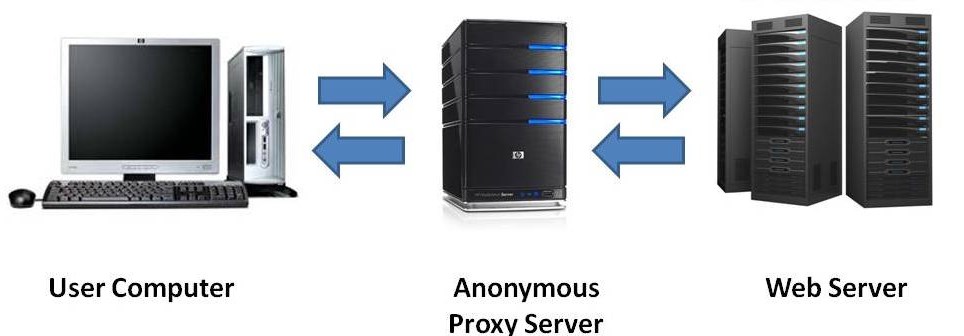
anonymous proxy server Archives
Tor vs. Proxies, Proxy Chains and VPNs

Introduction[edit]
Proxies are famous for "anonymity on demand". Acting as an intermediary, proxy servers relay your traffic to the destination and send the answer back to you so that the destination server potentially only sees the proxy and not your IP address: [1]
Instead of connecting directly to a server that can fulfill a requested resource, such as a file or web page for example, the client directs the request to the proxy server, which evaluates the request and performs the required network transactions. This serves as a method to simplify or control the complexity of the request, or provide additional benefits such as load balancing, privacy, or security. Proxies were devised to add structure and encapsulation to distributed systems.
There are two basic types of proxy server: [1]
- Open proxies: these forward requests from and to anywhere on the Internet and are accessible by any Internet user. [2]
- Anonymous proxies reveal their identity as a proxy server but do not disclose the client's originating IP address.
- Transparent proxies also reveal their identity as a proxy server, but the originating IP address is accessible due to factors such as the HTTP header. The benefit of these proxies is the ability to cache websites for faster retrieval.
- Reverse proxies: these connect the Internet to an internal network. Therefore, users making requests connect to the proxy and may not be aware of the internal network as the response is returned as if it came from the original server.
There are no known HTTP(S) or SOCKS4(a)/5 proxies that offer an encrypted connection between itself and the user. Therefore, the Internet Service Provider or any man-in-the-middle[archive] can see connection details, including the destination IP address. If the destination server is not using SSL/TLS, then the entire content of traffic is vulnerable as well.
As noted above, some open HTTP(S) proxies send the "HTTP forwarded for" header which discloses a user's IP address. HTTP(S) proxies that do not send this header are sometimes called "elite" or "anonymous" proxies. There are no known legitimate and free public HTTP(S) or SOCKS4(a)/5 proxies.
Comparison Tables[edit]
The tables below briefly compare the features offered by proxies found on many proxy sharing websites with various anonymization services.
Table:Proxy Type Feature Comparison
Table:Anonymization Service Feature Comparison
Conclusion[edit]
Proxies are highly susceptible to the misuse and theft of user data: many proxies (HTTP/HTTPS/SOCKS) are computers that have been hijacked by hackers or criminals, or are honeypots exclusively offered for the purpose of user observation. Even if they were legitimate, any single operator can decide to enable logging. In addition, some proxies automatically reveal the user's IP address to the destination server.
At best, proxies only offer weak protection against destination website logging, and they offer no protection against third party eavesdropping. For these reasons their use is strongly discouraged.
Introduction[edit]
This section compares the use of CGIproxies[archive] in Mozilla Firefox on the host without utilizing a platform like Whonix ™ or Tails. A CGI web proxy: [20]
... accepts target URLs using a Web form in the user's browser window, processes the request, and returns the results to the user's browser. Consequently, it can be used on a device or network that does not allow "true" proxy settings to be changed.
This means CGIproxies provide Internet pages with a form field in which the user can input the target address they wish to visit anonymously. The web proxy subsequently delivers the content of the requested website and automatically patches all links to use the web proxy when clicked. When using web proxy services the browser configuration does not need to be changed.
In comparison to network proxies, CGIproxies have the disadvantage of not being able to replace each link correctly, in particular on websites with JavaScript code. This makes it easier for the user's IP address to "leak" to the web server, which the proxy should actually prevent. The https://ip-check.info[archive] anonymity test displays the weakness of some web proxies in the comparison table below.
It is also important to note that CGIproxies can potentially only anonymize browser traffic and not the traffic of other applications; but to be fair, they do not claim more than anonymizing browser traffic.
Comparison Tables[edit]
To interpret the table below, refer the Wikipedia CGIProxy entry[archive] and the following legend.
Legend
- Broken: The real IP address is revealed.
- *: The highlighted service does not reach the test site if JavaScript is activated. It parses so poorly that the browser may leave the service silently in some cases.
- OK: no leak found.
- ?: Untested and therefore unknown.
- NI: Not installed by default.
- DE: Deactivated even if installed.
- RA: Recommended against by maintainers.
- 1 Encrypted connection to the CGI proxy (SSL/TLS) 2 or Tor exit relay.
- 2 Uses a proper SSL/TLS certificate recognized by certificate authorities.
Table:CGIproxies vs. Anonymization Software/Platforms
| Software / Provider | HTML/CSS/FTP | JavaScript | Java | Encrypted 1 |
| Whonix | OK | OK | NI DE RA OK | Yes |
| Tails | OK | OK | NI DE RA ? | Yes |
| Tor Browser | OK | OK | NI DE RA (Broken) | Yes |
| Anonymouse | Broken | Broken* | Broken | Premium only |
| WebProxy.to | OK | Broken | Broken | No |
| KProxy | Broken | Broken* | Broken | Yes |
| Guardster | OK | Broken (if allowed)* | Broken | Premium only |
| Megaproxy | Broken | Premium only | Premium only | Yes |
| Proxify | Premium only | ? | ? | ? |
Links to Software / Provider and Tests[edit]
In the following table, "(check manually)" means enter the test link manually in the browser.
Conclusion[edit]
In comparison to Tor, CGIproxies are only one hop proxies. This means they know who is connecting and the details of the requested destination server resource. This makes CGIproxies far inferior to Tor because they could potentially read all transmissions, even if entering SSL/TLS protected domain names.
Due to these serious disadvantages, it is not worthwhile discussing other security features which have been canvassed in other wiki chapters comparing Whonix ™, Tails and Tor Browser (such as UTC timezone and fingerprinting).
Introduction[edit]
Isn't seven proxies (proxy chains) better than Tor with only three Hops?
Some readers might be familiar with the Internet meme: "Good luck, I'm behind 7 proxies", which is sarcastic retort sometimes used when somebody threatens to report you to authorities, or claims they can identify your location. [21]
In short, multiple proxies used in combination are not more secure than Tor; many people are unaware of this fact. As outlined above, proxies are not very secure.
In contrast, the Tor design ensures the first hop (Tor relay) is unable to see the IP address of the last hop because it cannot decrypt the message for the second hop. If one hop can be trusted, then the connection is secure; see Which Tor node knows what?[archive] and the onion design to learn more.
Comparison[edit]
The information available to each of the three Tor relays is summarized below.
Table:Tor Node (Relay) Information Awareness[22]
| Category | User | Bridge Node/Entry Guard | Middle Node | Exit Node |
|---|---|---|---|---|
| Tor user's IP/location | Yes | Yes | No | No |
| IP of bridge node or entry guard | Yes | Yes | Yes | No |
| Message for bridge node or entry guard | Yes | Yes | No | No |
| IP of middle node | Yes | Yes | Yes | Yes |
| Message for middle node | Yes | No | Yes | No |
| IP of exit node | Yes | No | Yes | Yes |
| Message for exit node | Yes | No | No | Yes |
| IP of destination server | Yes | No | No | Yes |
| Message for destination server | Yes | No | No | Yes |
In comparison to Tor, proxies have serious weaknesses, even when SOCKS proxies or "elite"/"anonymous" proxies are utilized. Firstly, all connections between the user and all proxies in the chain are unencrypted. This holds true irrespective of the use of SSL/TLS. For demonstration purposes, assume a user is connecting to an SSL/TLS protected web server. In human terms, this is basic sketch of how the package for the first proxy in the proxy chain would appear:
- Proxy1, please forward "forward to Proxy3; forward to Proxy4; forward to Proxy5; forward to https://encrypted.google.com[archive] 'c8e8df895c2cae-some-garbage-here-(encrypted)-166bad027fdf15335b'" to Proxy2?
Notably, the actual transmission is safely encrypted and can only be decrypted by the HTTPS protected webserver, but every proxy will see its predecessor IP address and all successor IP addresses. There is simply no way to encrypt that information in an attempt to mirror Tor onion functions. The proxy protocols (HTTP(S), SOCKS4(a)/5) do not support encryption.
It is clear that proxy chains require trust to be placed in every successor proxy concerning the IP address. However, placing trust in open proxies is also misguided for the following reasons:
- Most are a simple misconfiguration; the owners are not aware of the situation and did not intend on public access in the first place.
- Many are compromised machines (worm infected).
- Some are honeypots that engage in logging or active exploits (DNS spoofing, protocol spoofing, SSL/TLS spoofing).
- Few are provided by generous people who only have good intentions in providing the best possible anonymity (similar to most Tor server administrators).
The above factors may not apply for proxy chains of SSH and/or encrypted VPN servers, but this has not been researched yet. Nevertheless, it is not possible to access numerous SSH and/or VPN servers for free (without hacking) and/or anonymous payment.
Comparison[edit]
Overall, there are a number of serious security and anonymity risks in wholly relying on VPNs; objectively speaking, Tor is a far safer configuration.
Table:Tor vs. VPN Comparison
| Category | Discussion |
|---|---|
| Browser Fingerprinting | Even when a virtual or physical VPN-Gateway is used, browser fingerprinting problems means it is only pseudonymous rather than anonymous. |
| Clearnet Risk | It is trivial to trick client applications behind a VPN to connect in the clear. [23] |
| Fail Open Risk | Most VPNs fail open and do not configure basic cryptography properly -- if they even use a proper cipher at all. [23] |
| Fingerprinting |
|
| Logging Risk | Unlike Tor, VPN hosts can track and save every user action since they control all VPN servers. The administrators and anyone else who has access to their servers, either knowingly or unknowingly, will have access to this information. |
| Multi-hop VPNs | Advertisements for double, triple or multi-hop VPNs are meaningless. Unless the user builds their own custom VPN chain by carefully choosing different VPN providers, operated by different companies, then they are fully trusting only one provider. |
| Software |
|
| TCP Timestamps | The fundamental design of VPN systems means they do not normally filter or replace the computer's TCP packets. Therefore, unlike Tor they cannot protect against TCP timestamp attacks. |
| Trust | VPN providers only offer privacy by policy, while Tor offers privacy by design:
|
| VPN Configuration | If VPN software is run directly on the same machine that also runs client software such as a web browser, then Active Web Contents can read the real IP address. This can be prevented by utilizing a virtual or physical VPN-Gateway or a router. However, be aware that active contents can still reveal a lot of data concerning the computer and network configuration. |
| VPN Server Security | The Snowden documents describe a successful Internet-wide campaign by advanced adversaries for covert access to VPN providers' servers. [26] |
Whether it is worth combining Tor with a VPN -- either as pre-Tor-VPN (user → VPN → Tor) or as post-Tor-VPN (user → Tor → VPN) -- is a controversial topic and discussed on the Tor plus VPN[archive] (w[archive]) page. If this configuration is preferred, it is easy to set up with Whonix ™; see Tunnel Support.
Criteria for Reviewing VPN Providers[edit]
- place of incorporation
- incorporation verifiable [27]
- ownership / shareholders
- usability votes, token system required
- has a free service or limited use free service
- accepts Bitcoin payments
- accepts other anonymous cryptocurrency payments like Monero
- accepts cash payments
- JavaScript-free ordering possible
- anonymous sign-up allowed
- sign-up does not require email address
- VPN client software is Freedom Software
- can be used with Freedom Software like OpenVPN
- no log policy
- known spokesperson
- third party audited
- popularity in Whonix ™ forums
- popularity in external VPN reviews
- overall popularity online
- known cases of malicious activity
- long term track record
- can be connected to by TCP
- can be connected to by UDP
- supports tunneling TCP
- supports tunneling UDP
- VPN with Remote Port Forwarding (for Hosting Location Hidden Services)
- Freedom Software server source code
Tor and Proxies Comparison
This was originally posted by adrelanos (proper) to the TorifyHOWTO/proxy[archive] (w[archive]) (license[archive]) (w[archive]). Adrelanos didn't surrender any copyrights and can therefore re-use it here. It is under the same license as the rest of the page.
Gratitude is expressed to JonDos[archive] for permission[archive] to use material from their website. (w[archive]) (w[archive]) [28] The "Tor and Proxies Comparison" chapter of the "Tor vs. Proxies, Proxy Chains and VPNs" wiki page contains content from the JonDonym Other Services[archive] documentation page.
Whonix ™, Tails, Tor Browser and CGIproxies Comparison
Appreciation is expressed to JonDos[archive] (Permission[archive]). The "Whonix ™, Tails, Tor Browser and CGIproxies Comparison" chapter of the "Tor vs. Proxies, Proxy Chains and VPNs" wiki page contains content from the JonDonym documentation Other Services[archive] page.
Tor and Proxy Chains Comparison
This was originally posted by adrelanos (proper) to the TorFAQ[archive] (w[archive]) (license[archive]) (w[archive]). Adrelanos didn't surrender any copyrights and can therefore re-use it here. It is under the same license as the rest of the page.
Tor and VPN Services Comparison
Appreciation is expressed to JonDos[archive] (Permission[archive]). The "Tor and VPN services Comparison" chapter of the "Tor vs. Proxies, Proxy Chains and VPNs" wiki page contains content from the JonDonym documentation Other Services[archive] page.

Jobs in USA
Search engines: YaCy | Qwant | ecosia | MetaGer | peekier | Whonix ™ Wiki
Follow: 


![]()









![]()



Donate: 








Share: Twitter | Facebook

![]()
This is a wiki. Want to improve this page? Help is welcome and volunteer contributions are happily considered! Read, understand and agree to Conditions for Contributions to Whonix ™, then Edit! Edits are held for moderation. Policy of Whonix Website and Whonix Chat and Policy On Nonfreedom Software applies.
Copyright (C) 2012 - 2020 ENCRYPTED SUPPORT LP. Whonix ™ is a trademark. Whonix ™ is a licensee[archive] of the Open Invention Network[archive]. Unless otherwise noted, the content of this page is copyrighted and licensed under the same Freedom Software license as Whonix ™ itself. (Why?)
Whonix ™ is a derivative of and not affiliated with Debian[archive]. Debian is a registered trademark[archive] owned by Software in the Public Interest, Inc[archive].
Whonix ™ is produced independently from the Tor®[archive] anonymity software and carries no guarantee from The Tor Project[archive] about quality, suitability or anything else.
By using our website, you acknowledge that you have read, understood and agreed to our Privacy Policy, Cookie Policy, Terms of Service, and E-Sign Consent. Whonix ™ is provided by ENCRYPTED SUPPORT LP. See Imprint, Contact.
Tag: High Anonymity proxy
A proxy server is a bridge between the internet and the users. It is a server liaising and creating a separation between the users and the corresponding websites that they browse. Considering the demands, use cases or company policies, proxy servers provide a range of capabilities, privacy and protection while the users stay connected to the internet.
The internet traffic passes through a proxy server while it is on the way to the specified website address. Later the response comes through the proxy server while it passes on the data to the user from the website.
Proxy servers with recent trends work beyond than just passing on the web requests calling it network performance or data protection. It functions as a web filter cache data, offer network connections that can be shared to enhance the user requests. An efficient Proxy Server is good to provide privacy and protect the network and users from malicious interference
Why Use a Proxy?
Proxies help you browse the web by hiding your IP address for no one to see. When the internet is connected to the proxy server, the home IP address will not be displayed, however the IP address of the proxy server will be shown. This helps to provide more privacy while you are browsing the internet.
There are different types of proxies available to provide you with service some are available for free and some are paid version, however, in comparison the paid services are more secure and trustworthy.
How Does a Proxy Server Operate?
Each computer has a different IP (Internet Protocol) Address when it is connected to the Internet.
When the user sends a web request, the request reaches the proxy server first, while the proxy server makes your web request on your behalf, gathers the required information from the web server and passes on the web page information to help the user see the page in the web browser.
Once the web user, sends a request, proxy server liaises the web requests and it has the capability to alter the IP address, so the web server will not be able to identify from where the request has come. The proxy server can encrypt the user’s data when in transit and can terminate access to specific web pages based on IP addresses.
Types of Proxy Servers
There are different types of proxies and each function unlike the other. It is vital to know about the functionality of the proxy server and check if the capabilities of the proxy server meet the user demands
Transparent Proxy
This type of proxy server will transmit the information to the web server with actual IP address. This type of proxy server is used by schools, public libraries and businesses to ensure content filtering to create server and client ends.
Anonymous Proxy
An anonymous proxy server will showcase itself as a proxy to destined server, and it does not display the actual IP address of the user to the website – this prevents identity theft and ensures user-privacy while browsing. Anonymous proxy can deny any websites to target the users with their marketing-based content.
Distorting proxy
This is more like anonymous proxy however produces a false IP address showing that the user is from a different location to ensure content restrictions.
High Anonymity proxy
High Anonymity proxy servers change the IP address that they showcase it to the web server in regular intervals, making it challenging for the websites to track the flow of traffic
How to Setup a Proxy
Internet Explorer Proxy Settings
- Click Tools
- Choose Internet Options
- Choose the Connections Tab
- Go to LAN settings and click on it
- Select “Use a proxy server for your LAN” option
- Enter the Port Number and the IP Address of the Server
- Click OK
Google Chrome Proxy Settings
- Select the button on the topmost right corner with the wrench picture on it. (It’s the control and customize button.
- Click on Change Proxy Settings
- Click LAN Settings
- Select “Use a proxy server for your LAN” option
- Enter the Port Number and the IP Address of the Server
- Click OK
Why Should You Use a Proxy Server?
Proxy servers are used for a variety of reasons as per the requirements of the organizations and individuals
Take control of the internet usage – Proxy servers are used by parents to monitor their kids’ internet activities and used by the organizations to take control of the employees’ activities when connected to the internet.
Bandwidth savings and enhanced speeds – A good proxy server can benefit the organization with enhanced network performance. Proxy servers save a copy of popular websites and shares the saved copy of the website when the user request to visit the same. This helps to enhance the network performance of the company by saving a lot of bandwidth.
Privacy benefits – Both organizations and individuals mostly browse the internet in a private mode. Proxy servers are equipped to change the actual IP addresses that any web request possess. The recipient server therefore would not know from where the original request has come.
Enhanced security – Proxy servers help to encrypt the requests transmitted between the web and the server to deny malicious interference. Organizations can collaborate a Virtual Private Network with the proxy server to provision remote users with secure and private access through the company proxy.
Gain access to blocked resources – Proxy servers allow users to access any uncensored internet.

Related Sources:
https://cdome.comodo.com/blog/what-is-dns-filtering/
https://cdome.comodo.com/virtual-proxy-browser.php
https://cdome.comodo.com/network-security.php
https://cdome.comodo.com/dns-internet-security.php
https://cdome.comodo.com/secure-internet-gateway.php
JonDo
JonDo started as a German university project called Java Anon Proxy (JAP) and has become a robust anonymity tool that, like Tor, sends traffic through several independent servers.
Unlike Tor, however, the JonDo network mixes servers run by volunteers with others maintained by a parent company. The arrangement gives users a choice of speeds: 30-50 kBit/s (about the speed of an analog modem connection) for free, >600 kBit/s for a fee. For a more detailed comparison and price list, see: https://anonymous-proxy-servers.net/en/payment.html.
General Information
Installation
To use the JonDo network, called JonDonym, you'll need to download the JonDo client for your operating system from https://www.jondos.de/en/download. Versions are available for Linux (about 9 MB), Mac OS X (about 17 MB) and Windows (about 35 MB).
Once you have download the client, install it as you would any software for your platform. You may be asked if you wish to install it on your PC or if you wish to create a portable version. For our example, we will assume you are installing JonDo on a PC.
Windows users also may be invited to install the JonDoFox web browser, discussed below.
Configuration and Usage
When you first start JonDo, you can choose the language you want displayed.
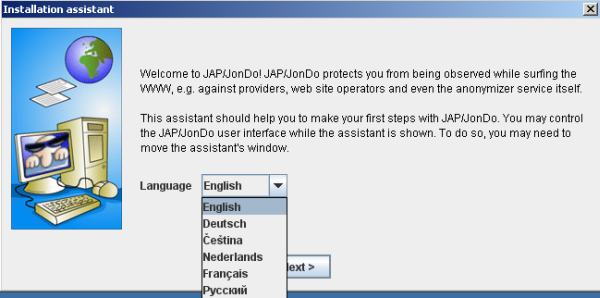
Next, you can choose the level of detail you wish to see when using the service. Inexperienced users should choose "Simplified view".
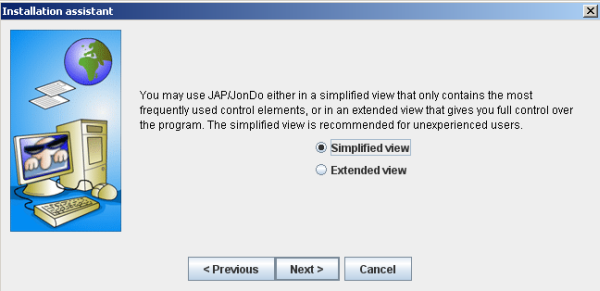
On the next screen, the Installation assistant asks you to choose the Web browser that you want to use the JonDo proxy tool. Click on the name of your browser, and follow the instructions.
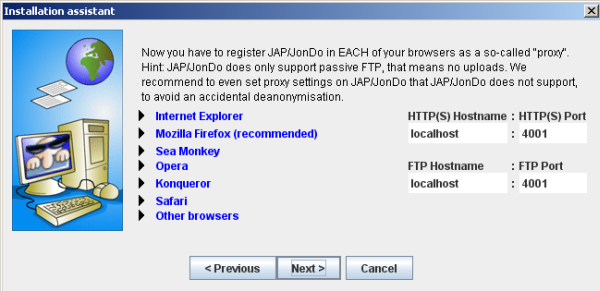
Once that is completed, JonDo asks you to test your configuration. In the control panel, switch anonymity to Off and then try opening a Web site with the browser you have just configured.

If JonDo shows you a warning and you have to choose "Yes" to view the Web site, everything is configured properly and you can select "The warning is shown. Websurfing is possible after confirmation". If any other description applies to you, choose it and the Installation assistant will give you more information on how to solve the problem.

Now take the second step to insure a proper configuration: Switch anonymity to "On" in the control panel and open a random Web site with the browser you have configured.
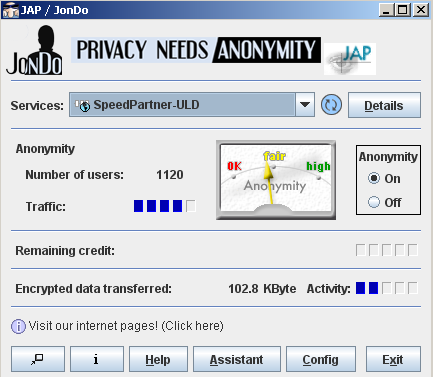
If the Web site loads, everything is fine and you can click "Connection established, websurfing is fine". If another description applies to you choose that one and the Installation assistant will help you solve the problem.

We're almost done. You have successfully configured your browser to connect through the JonDo network. Now, you should also configure your browser so that it doesn't accidentally leak any information. Click on the name of your browser to start the process.
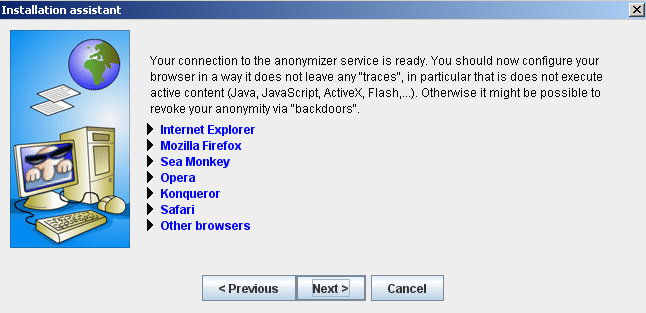
If the standard JonDo servers are already blocked in your country, you should try the anti-censorship option. Click "Config" in the control panel and select the Network tab. Click on "Connect to other JAP/JonDo users in order to reach the anonymization service". Read the warning and confirm by clicking "Yes".
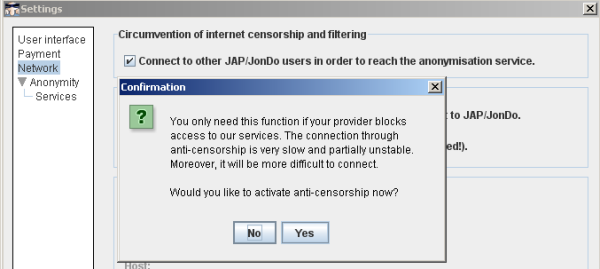
To make sure you configured your browser correctly, you can point it to http://what-is-my-ip-address.anonymous-proxy-servers.net which will tell you if there is any problem.
JonDoFox
For additional security, the JonDoNym team offers a modified Firefox Web browser called JonDoFox. Similar to the Tor browser bundle, it prevents leaking additional information while using the anonymization tool.
You can download the tool at https://anonymous-proxy-servers.net/en/jondofox.html.
What’s New in the anonymous proxy server Archives?
Screen Shot

System Requirements for Anonymous proxy server Archives
- First, download the Anonymous proxy server Archives
-
You can download its setup from given links:


